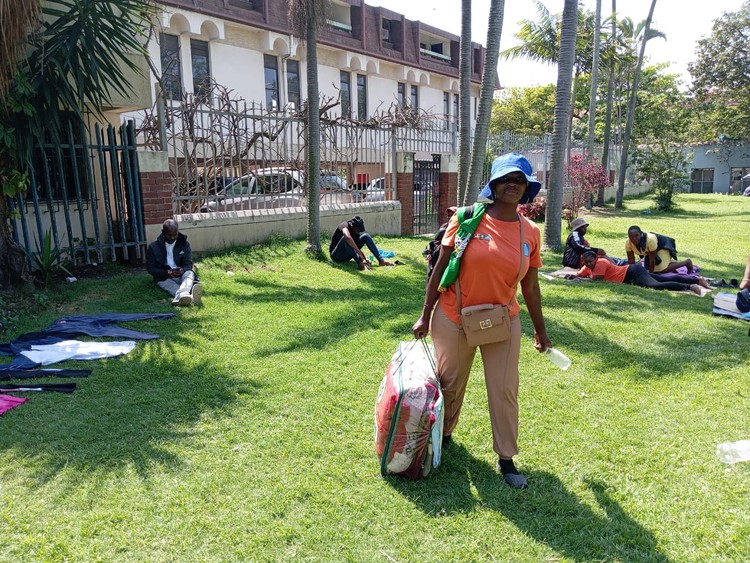Mail & Guardian books editor Shaun de Waal wrote in 2000 of his fatigue at the inevitable question visiting journalists interested in South Africa’s literature posed: Where are the new young Black writers? “There seemed to be an expectation that as apartheid collapsed and its legacy faded, a new generation of young Black writers would emerge in their full glory, spurred on by the new freedoms of a new democracy,” De Waal observed. “It was thought that the combination of apartheid censorship and lack of educational advantage had held them back, but now their time had come.”
The question wasn’t without merit. A decade had passed since Nelson Mandela’s release from prison and instead of the expected generation of fresh young Black writers, it was still the old white voices – as signified by JM Coetzee winning the Booker Prize in 1999 for Disgrace – telling what might be called the South African story. Yet in 2000, something was stirring. Had De Waal waited another year, he would have been able to point out two emerging writers: K Sello Duiker, the Soweto-born author of Thirteen Cents (2000) and The Quiet Violence of Dreams (2001), and Phaswane Mpe, whose first novel Welcome To Our Hillbrow came out in 2001.
Mpe’s novel explores the inner city, migration, xenophobia and Aids. Surprisingly, the 20-year anniversary of that South African literary landmark has not been widely marked.
“The very title of Conrad’s [novella], whatever other resonances it comes to have, is literally determined by the reference to cartography,” noted Marxist critic Fredric Jameson about Joseph Conrad’s Heart of Darkness in 2007. For slightly different reasons, the same could be said about Welcome To Our Hillbrow, a novel that is self-conscious of space and the cartography of the inner-city neighbourhood of Hillbrow, Johannesburg. The novel’s obsession with maps and map-making is self-referential but also extends outwards. Along with Duiker, Mpe occupies a special place in the post-democratic literary map of South Africa. The two, although their lives were cut short, inaugurated in different ways a novel way of writing the new nation.
Related article:
Text Messages | Telling stories for young minds
Sometimes Welcome To Our Hillbrow feels as if its narrator has recently arrived in the suburb and is keen to quickly get to know his way around what must initially appear an intractable and dangerous labyrinth. “If you are coming from the city centre, the best way to get to Cousin’s place is by driving or walking through Twist Street, a one-way street that takes you to the north of the city. You cross Wolmarans and three rather obscure streets, Kapteijn, Ockerse and Pieterse, before you drive or walk past Esselen, Kotze and Pretoria Streets. You will then cross Van der Merwe and Goldreich Streets,” the narrator tells us in the first chapter, aptly titled “Hillbrow: The Map”.
Welcome To Our Hillbrow is also a guide to how the city defines itself in relation to Hillbrow and what it represents. “You already knew that Hillbrow was a menacing monster, so threatening to its neighbours like Berea and downtown Johannesburg that big, forward-looking companies were beginning to desert the inner city, heading for the northern suburbs such as Sandton.”
The chapter is like a warning. The narrator draws up what could be a survival guide to what has been portrayed in the popular imagination since 1994 as the most dangerous place not only in Johannesburg but also South Africa. We read of torsos ripped open by butcher’s knives, rapes and muggings; of a stratified soundscape, the burst of gunfire overlaid with police sirens and the screams of victims of violence; of streets on which strut drug dealers and “aggressive prostitutes”; and of New Year celebration rituals in which projectiles – including fridges – take flight from balconies on to the streets below.
By any definition, Hillbrow is a place apart. It seems to exist in its own temporality, where time is more elastic than anywhere else in South Africa. “It amazed you that there should be so many people jostling one another in the streets at nine in the evening,” says the narrator.
Idyll vs evil
In the first chapter, Refentse, who came to Johannesburg from then Northern Province, now Limpopo, is referred to as a “child of Tiragalong”. By the second chapter, “Notes from Heaven”, Refentse has become a “child of Tiragalong and Hillbrow”. The quick embrace of both is something on which University of the Witwatersrand (Wits) literature professor Bhekizizwe Peterson remarked in April, shortly before his death on 16 June. Peterson observed that Mpe had rewritten the dichotomy between the two: “His characters occupy both the city and the country, and there is no straightforward contrast in which the one is good and the other one is bad.”
In trying to locate Mpe’s place in South Africa’s literary genealogy – or, as the map is so important to Mpe, the place of Welcome To Our Hillbrow in South Africa’s literary cartography – Peterson explained that when South African writers started imagining the city and the country, the two were usually thought of in binary terms: the city was evil while the country was an idyll.
Related article:
Long Read | Bheki Peterson and the art of hopeful futures
RRR Dhlomo’s novella An African Tragedy (1928), a Christian morality tale, is an early exemplar of this phenomenon. In it, two lovers leave their rural area for the city, where they become corrupted. “That’s essentially the tragedy referred to in the title. That became a kind of template where there was the assumption both among writers and some of the colonial authorities that the city exercised a corrupting influence on those who moved to it; that the city was also a space of disease; so the lead character in An African Tragedy also falls ill. The city and disease and contagion are early motifs and tropes then,” said Peterson.
Though Welcome To Our Hillbrow explores disease, the HIV and Aids pandemic and living in the city, its antecedents are elsewhere. It has more in common with Es’kia Mphahlele and Peter Abrahams, and the modernist writers of what is called the Drum generation – Todd Matshikiza, Henry Nxumalo, Can Themba and others – than with Dhlomo. Peterson noted that Mphahlele and his generation “sort of rehabilitate the city, and start to present it as a modern city, a space that should be celebrated despite the experiences of oppression and exploitation”. In their fiction, these writers start to suggest that “there is no unproblematic rural space to hold on to”, that even the so-called rural idyll is under the control of white people and the colonial administration.
Mpe’s humanism
Mpe was born in then Pietersburg in 1970 and moved to Johannesburg in 1989 to study for his bachelor of arts degree at the University of the Witwatersrand. As in the novel, when Mpe moved to Johannesburg, he lived in Hillbrow with a cousin. Hillbrow, formerly a whites-only suburb, had since the 1980s become a home for interracial couples, bohemians and Black people. After Mandela’s release in February 1990, Blacks from other parts of Africa streamed into Hillbrow, turning it into a veritable babel, what some call Afropolitan or, as Mpe’s narrator puts it, “the sanctuary in which makwerekwere basked”. Kwerekwere is the derogatory name for migrants in South Africa.
Even among these surging multitudes from Mozambique, Nigeria, Zimbabwe, Senegal, Tanzania and the South African hinterlands, Mpe never shed his sense of botho, ubuntu, a shared humanism he had been taught in the Northern Province. When Grace Khunou, director for leadership and transformation at the University of South Africa, enrolled for her doctorate in sociology at the Wits Institute for Social and Economic Research (Wiser) in 2003, she shared an office with Mpe and witnessed his kindness and generosity. Mpe would meet people for the first time in a pub and immediately take to them, she said. In most of South Africa, this might be admirable. In Hillbrow, it is considered foolhardy.
Related article:
Remembering Zindzi Mandela, the writer
Khunou explained that Mpe “didn’t have a persona for the city and a persona for the rural area”. In both spaces, his character was based on caring, sharing, helping others and humanising the individual considered the other. It’s difficult to think of a more compelling and sympathetic piece of fiction produced in South Africa in the past two decades that humanises the other – in a different context, Jameson wrote of this category as “the quintessential ogres and bogeymen of childhood nightmares” – better than Welcome To Our Hillbrow.
There is a touching episode in the novel that shows Mpe’s humanism. Cousin is walking to Wits with Refentse and on seeing the two, an old man who survives by begging exclaims: “Aibo!” Cousin ignores the man but Refentse acknowledges him. Cousin rebukes Refentse, telling him he shouldn’t “go around greeting every fool in Hillbrow”. Yet the two developed what in Johannesburg comes close to a kinship: “In the five years you had known him, you had become friends without ever saying anything to each other, except for the mutually warm greetings.”
Mpe’s kindness extended to his fellow students. Khunou recalled many people visiting Mpe, looking for advice and guidance. “He had botho. He was a teacher and mentor.” One of these people was poet, educator and bandleader Kgafela oa Magogodi.
First of its kind
Mpe enrolled for a masters in African literature after completing his bachelor’s degree. His area of interest was author and translator Sol Plaatje, particularly his novel Mhudi. “You can see that the work [Welcome To Our Hillbrow] has a strong sense of African orature, multiple perspectives in its narration, multilayered sense of time and multiple temporalities. This is what he picks from Plaatje’s work,” said Peterson.
After his masters, Mpe went to Oxford Brookes University in Oxford, England, for a year, where he studied for a diploma of advanced study in publishing. His poems and short stories had been appearing in magazines such as Imprint, New Coin and English Academy Review since 1995, all of which was leading up to the publication of Welcome To Our Hillbrow.
Until this manuscript came along, the University of KwaZulu-Natal Press (UKZN Press) had never published fiction. At the turn of the century, UKZN Press publisher Glenn Cowley alerted freelance editor Elana Bregin about a manuscript he had just received. “It was fiction, stream of consciousness fiction, and completely different from the usual kind of thing that the press did,” Bregin recalled in March. “Even though it really needed some direction, you couldn’t mistake the shining in it. You know, those manuscripts that are raw and different but there is just a shining that you can’t teach.”
Related article:
Niq Mhlongo and the return of the short story
There was a “big debate” at the publishing house about whether to take it, “because it wasn’t the usual thing that fitted into their usual market at that time”. Unsurprisingly, a unanimous decision was made to publish the manuscript and the responsibility for editing it fell to Bregin. “That kind of editing was my speciality, that is, dealing with new voices that didn’t fit into the literary mould. So the editing becomes the delicate balance of not wanting to override the voice, but bringing it into some kind of more structured form that is acceptable as a book.”
Mpe wrote Welcome To Our Hillbrow in one sitting. “He said it just came to him and he started writing and went on through the night and that was it,” Bregin said, as if the ancestors and gods handed the text to him in the way prophets are said to receive instruction from deities. Mpe signed Bregin’s copy of his novel with, “Thank you for combing through the jungle in search of an elusive story and thanks for discovering something.”
So groundbreaking was the novel for its publisher that soon others followed. “These kinds of semi-autobiographical or autobiographical works, which we started getting after Phaswane, he kind of opened the door for that at the UKZN Press. He was the forerunner,” said Bregin. Notable books that followed at UKZN Press are Siphiwo Mahala’s debut novel When a Man Cries (2007) and Thando Mgqolozana’s A Man Who Is Not a Man (2009), which was later adapted into the film Inxeba | The Wound.
More than just a book
The novel saved Mpe’s life. Literary scholar Sarah Nuttall writes in an essay, “Literary City” in the book Johannesburg: The Elusive Metropolis (2008), that Mpe told his colleagues at Wiser how he felt suicidal at the time of writing the book. The novel “becomes an extended suicide note that also comes to save his life, by giving him a renewed desire for writing”, writes Nuttall.
Mpe was a spiritual person, visible even in the way he related to books. Whenever Mpe read a novel or book that touched him, Khunou recalled, he would carry it in his bag for months afterwards. He seemed to be seeking a deeper kinship with the text beyond merely reading it, an act the ancients would have been bemused by and yet completely understood.
Khunou also recalled that Mpe liked using the Sepedi phrases badimu ke batho and ke rona badimu. When read together, the meaning is profound: the gods are humans, and we are gods.
In the chapter “Notes From Heaven”, Mpe was already prefiguring and contemplating the afterlife. “Heaven, in the book and within Mpe’s frame of mind at the time of writing, ‘is not some far-off place’ but rather a continuum between life and death, a place of insights, from which to view and review ‘our world’,” writes Nuttall.
Related article:
An African tragedy at the heart of Soyinka’s satire
It’s no surprise then that Mpe abandoned his doctoral studies (examining sexuality) to train as a ngaka, a traditional healer. In much the same way he made no distinction between the country and the city, Mpe probably saw no difference between being a writer and a healer. “He saw his new career path as a continuation of the old one: healers understand physical malaise as an expression of spiritual and emotional dysfunction,” South African journalist Liz McGregor wrote in The Guardian newspaper. “Cure means constructing a narrative of the patient’s life to pinpoint the problem. He hoped that listening to his patients’ stories might help dislodge the block that frustrated his creative writing.”
In the month he was meant to leave Wiser for his new calling, as he was in the process of packing, Mpe went home to attend a funeral. He never returned to Johannesburg. Mpe died on 12 December 2004, likely from complications related to HIV and Aids. He was only 34, and left behind a son and daughter.
“To burn so bright, and to die so young,” wrote Mail & Guardian columnist John Matshikiza. In the same obituary, he also paid tribute to K Sello Duiker, who died a little over a month later, on 19 January 2005.
“Phaswane Mpe never told us this, not in so many words anyway, but what he was writing out was the process of his own possible dilemma. His one and only novel, Welcome To Our Hillbrow, turns out to have been a warning, a commiserating, an all too powerful statement about the present that we are living in,” wrote Matshikiza.






